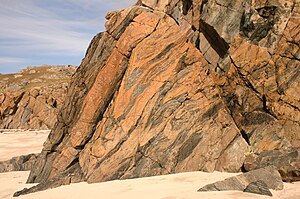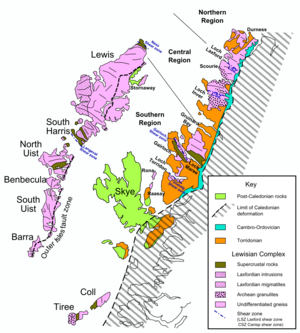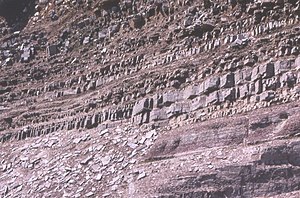Hebridean Terran
The Hebridean Terran in northwestern Scotland , which belongs to the North Atlantic Craton, forms one of the Terrans of the Caledonids . The Moine Thrust Belt separates it from the neighboring Northern Highlands Terran .
etymology
The name Hebridean Terran is derived from the archipelagos of the Outer and Inner Hebrides , which make up a large part of the surface of the terran . The word terran came from the Latin terra (earth).
General
The basement of the Hebriden-Terrans is of gneiss of Lewisian ( Archaikum and Paleoproterozoic established). The Neoproterozoic sediments of the Torridonian Supergroup lay discordantly over the basement , which in turn are discordantly overlaid by a sedimentary sequence of the Cambrian and Ordovician . During the Caledonian continental collision , the terran was part of the Laurentia foothills .
Spatial expansion
The Hebridean Terran stretches across the northwest coast of Scotland, across almost all of the islands in the Inner Hebrides, and across the entire Outer Hebrides. Very similar rocks are also found west of Shetland and on the continental shelf west and north of the Outer Hebrides, as has been confirmed by shallow drilling of the British Geological Survey and oil drilling . The full extent of the Hebridean Terran to the west is obscured by Mesozoic rifting.
Lithology
Lewisian

The Lewisian is composed predominantly of highly metamorphic gneisses with granitic chemistry, which went through a series of deformation and metamorphic phases, interrupted by the penetration of a significant gang of gang members . There are also mafic and ultramafic gneisses as well as rare metasediments.
Scourian
The original rocks of the Scourian were mainly intrusiva of granitic composition ( Tonalite , Trondhjemite and Granodiorite , original rocks of the later TTG gneisses ), which had penetrated BP in the period 3000 to 2700 million years . Towards the end of the Archean, they were deformed during the Badcallian and granulite facially metamorphosed. With the beginning of the Proterozoic, the Scourian rocks experienced a new deformation phase and a retromorphosis to the amphibolite facies . This event, known as the Inverian , coincided with the invasion of the Scourie dykes gang .
Scourie dykes
The Scourie dykes are a gang of doleritic composition. They invaded the gneiss after the tectono-metamorphic phases of the Badcallian and Inverian. For this reason they were used to distinguish the later deformations of the Laxfordian from the two early phases. Many dikes were intruded into the still hot crustal rock.
Laxfordian
During the Laxfordian , shear zones developed into which Scourie dykes were regulated concordantly as amphibolite packages. This deformation phase was accompanied by a retromorphism to amphibolite facial and locally even to green slate facial conditions.
Torridonian Supergroup
The Torridonian Supergroup is a sedimentary succession of the Neoproterozoic . It consists mainly of sandstones that come to lie discordantly on an eroded land surface with up to 300 meters of denivellation. The supergroup is further subdivided into the Stoer Group as well as the younger Sleat Group and Torridon Group . The Torridon Group discordantly overlays the Stoer Group and very likely also the Sleat Group. The position of the Sleat Group in comparison to the Stoer Group cannot, however, be recognized. Paleomagnetic measurements confirm that the angular discordance between the Torridon Group and the Stoer Group represents a significant layer gap . It is believed that the sediments of the Torridonian Supergroup were deposited during a rift phase .
Stoer Group
The Stoer Group is due on the Stoer Peninsula near Assynt in Sutherland . It usually begins with a basal breccia , the large clasts of which come from the underlying Lewisian. The breccia merges with the hanging wall into clayey sandstones, often criss-crossed by shrinkage cracks . Deposits from a pigtail system follow - sandstones with trough inclined layers and conglomerates. Lacustrine conditions then set in , recognizable by a thin sequence of siltstones and fine-grained sandstones alternating with clay-rich sandstones. The uppermost section of the Stoer Group again consists of plaited stream sediments, mainly sandstones with trough sloping layers.
Sleat Group
The Sleat Group is open-minded on Skye on the Sleat Peninsula . It apparently conforms to the Torridon Group, but in reality the contact corresponds to a significant shift gap. The contact to the Stoer Group is nowhere to be seen. It is assumed that the Sleat Group was sedimented after the Stour Group, possibly staggered in time in its own side basin. It is embedded in the Kishorn Nappe , which is part of the Caledonian thrust belt , which makes it difficult to correlate with other occurrences of the Torridonian Supergroup. Their stratigraphic structure is essentially dominated by coarse, feldspathic, fluvial sandstones ( arcs ). Gray shale clays, which were sedimented in lakes , also occur to a lesser extent.
Torridon Group
The Torridon Group was poured into an irregular surface relief with a denivellation of up to 600 meters. It reaches down to the previously deposited sediments of the Stoer Group and in places lies directly on the Lewisian. In the lowest section of the Torridon Group there is a basal breccia that merges into sandstones and less common shale clays in the hanging wall. These sediments as alluvial fans interpreted the progradierten in ephemäre lakes. The upper part of the Torridon Group consists of a sandstone sequence, which is generally finer-grained towards the hanging wall and which was deposited in a Bajada environment .
Sediments of the Kambro Ordovician
The sediments of the Kambro Ordovician form only a thin strip that lies between the Torridonian Supergroup in the west and the Moine Thrust in the east. They follow discordantly over the Lewisian or over the Torridonian supergroup. Their sequence can be divided into the Eriboll Group of the Lower Cambrian and the Durness Group of the Lower Ordovician .
Eriboll Group
The approximately 200-meter-thick Eriboll Group is built up from two formations , the Eriboll Formation at the base, followed by the overlying An-t-Sron Formation . The Eriboll Formation consists of two members , the basal quartzite member , a base conglomerate, and above that the pipe rock member , a heavily digested sediment of quartz arenites with the characteristic Skolithos or monocraterion trace fossils. The Ant-Sron-Formation consists of dolomitic siltstones of the Fucoid-Beds-Member and the overlying Salterella-Grit-Member , a diagonally layered sandstone unit.
Durness Group
The Durness Group follows the Eriboll Group concordantly. It contains several hundred meters of stromatolite- bearing dolomites , including limestone and chert nodules . Movements that occurred later on faults make correct thickness information difficult, but the Durness Group is likely to be over 1000 meters thick. The Durness Group is divided into seven formations.
Spatial organization
Improved geochronological work in the 1980s and 1990s has shown that the Hebridean terran is not of a uniform nature, but rather disintegrates into an amalgam of several crustal blocks or small cranes, which are characterized by their specific, tectono-metamorphic development over the course of the earth's history. After the Laxfordian ended , these small cranes came to rest during the Proterozoic in their current configuration in the Hebridean terran. The Lewisian Protolith Age is not uniform, as Whitehouse (1989) and Kinny and Friend (1997) clearly demonstrated. Accordingly, the following small cranes can be differentiated on the Scottish mainland (from north to south):
- Rhiconich Terran - northern crustal block or formerly northern district
- Assynt Terran - central crustal block or central district
- Gruinard Terran - central crust block or central district
- Gairloch Terran - southern crustal block or southern district
- Ialltaig-Terran - inserted, exotic crust chip
- Rona-Terran - southern crustal block or southern district
Kinny et al. Distinguish the following terranes in the Outer Hebrides (from north to south):
Then there are Coll and Tiree , who provide their own terran.
This terrain concept is now generally accepted, but there are still differences in the exact dimensions and accretion mode of the individual blocks.
Geological development
The earliest geological event in the Hebridean Terran is the intrusion of granites (precursors of the TTG gneiss) in the period from 3000 to 2700 million years BP. These intrusives were tectonized and metamorphosed into high-grade granulites during the Badcallian (around 2760 million years BP). The subsequent deformations of the Inverian and Laxfordian created the current arrangement of the individual blocks or subterranean in the time interval from 2400 to 1700 million years BP. Around 1200 million years BP, the Hebridean Terran came under the regime of expansion tectonics (rifting). The coarse-clastic Torridonian Supergroup was then poured into the resulting rift basin. This was followed by adjustments to the earth's surface, which left a layer gap of around 200 million years. The sedimentation then started again with the Torridon Group. After another, very extensive layer gap, the Cambrian Transgression followed with the deposition of shallow marine sandstones and carbonate rocks. The sedimentation persisted into the Ordovician. In the Silurian , the Hebridean terran was captured by the Caledonian mountain formation ( continent collision ), with the Northern Highland terran being pushed onto the Laurentian foreland.
Individual evidence
- ↑ a b c d e f Park, RG; Stewart, AD; Wright, DT: 3. The Hebridean terrane . In: Trewin NH The Geology of Scotland . Geological Society, London 2003, ISBN 978-1-86239-126-0 , pp. 45-61 .
- ↑ Zirkler, A., Johnson, TE, White, RW, Zack, T .: Polymetamorphism in the mainland Lewisian complex, NW Scotland - phase equilibria and geochronological constraints from the Cnoc an t'Sidhean suite . In: J. Metamorph. Geol. Band 30 (8) , 2012, p. 865-885 .
- ↑ Sutton, J .; Watson, J .: The pre-Torridonian metamorphic history of the Loch Torridon and Scourie areas in the north-west Highlands, and its bearing on the chronological classification of the Lewisian . In: Quarterly Journal of the Geological Society . tape 106 . London 1951, p. 241-307 .
- ↑ Kinny, PD et al: Proposal for a terrane-based nomenclature for the Lewisian Complex of NW Scotland . In: Journal of the Geological Society of London . 2005, p. 175-18 .
- ^ Whitehouse, MJ: Sm-Nd evidence for diachronous crustal accretion in the Lewisian complex of northwest Scotland . In: Tectonophysics . tape 161 , 1989, pp. 245-256 .
- ↑ Kinny, P. and Friend, C .: U-Pb isotopic evidence for the accretion of different crustal blocks to form the Lewisian Complex of Northwest Scotland . In: Contributions to Minerology and Petrology . 1997.
- ^ Love, GJ, Friend, CRL, Kinny, PD: Palaeoproterozoic terrane assembly in the Lewisian Gneiss Complex on the Scottish mainland, south of Gruinard Bay: SHRIMP U-Pb zircon evidence . In: Precambrian Research . tape 183 , 2010, p. 89-111 .



